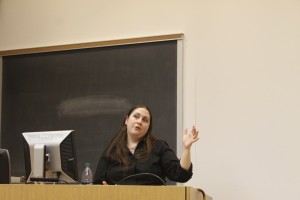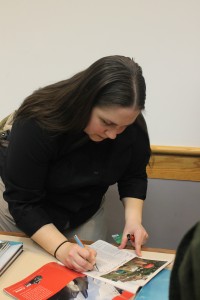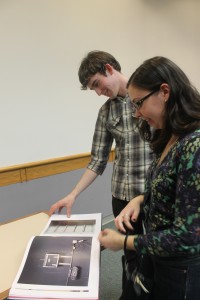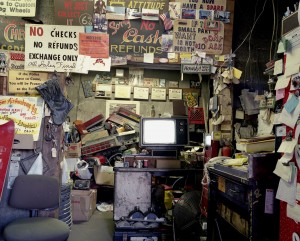http://www.thelaf.com/a-e/lisa-kereszi-visiting-artist-1.2814215
Tag: Lisa Kereszi
Last Fall, photographer Lisa Kereszi spend 5 days at Lafayette meeting with students and working on a project. She will be returning for the second half of her residency in March 2012 and will give an Artist talk on Wednesday March 7, 2012 at 4:15pm in Willaims Center for the Arts, Room 108. Imogen Cain (2012) interviewed Lisa to find about more about her process and her photographs:
1) Where do you get your inspiration from and who are your influences?
I think I get a lot of inspiration just from the world around me, and also the Southeastern PA world I grew up in – the suburbs of Philly, but not the Main Line. I also am an avid collector of old photos, ephemera, drawings, postcards. So, I draw a lot of inspiration form that. My photography is also an act of collecting, or scavenging, saving things for disappearance, in a way. I am also very indebted to the work of Walker Evans, whose trail I sniffed out while in the Easton area. I visited some of the sites he photographed back in 1935 when he passed through your area. This is part of why I was so interested to come to Lafayette to be an artist-in-residence. My Eastern European great-grandparents settled in Bethlehem, and raised my grandfather in the shadow of the same steel mill Evans photographed so starkly from the hill of St. Michael’s Cemetery. I had known that image the whole time I was a student and practitioner of photography, but had no idea I had such a personal connection to the place. This past visit, during the 1st part of my residency, I was able to make an interesting picture of the stacks reflected in my family’s front screen door on East 3rd Street. Other photographers whose work I feel connected to are Robert Frank, Brassai and Eugene Atget. I even share a birthday date with one of them!
2) What was it like to work for Nan Goldin?
It was a wonderful learning experience for a 21-year-old right out of college, practically. I recall distinctly sitting in my dorm room at Bard, paging through her book, the Ballad of Sexual Dependency, telling my then-boyfriend that I hoped to get a job working for her. Then, I sort of lucked into it. I had no idea about the big art world I was stepping into. I met John Waters and Philip Lorca diCorcia, and many of Nan’s friends who famously peopled her iconic pictures from the 70’s and 80’s: David Armstrong, Sharon, Bruce. Besides seeing how a well-known artist functions on a day-to-day basis, I got to assist her and be present while the exhibition and catalog for her retrospective at the Whitney, I’ll Be Your Mirror, was being put together. I also got private, up-close access to her files of original slides, most of which have never been seen by the public. Her work definitely influenced my use of light and color. I was drawn to her in the first place, so there must have been an artists connection there to begin with.
3) Why do you prefer analog photography?
I like the way color and light is rendered on film, or maybe I am just sued to it, and it works for me! also, when I do use a 4×5, the movements and focus detail that camera affords is unbeatable at $5 a shot, rather than buying an outrageously-expensive digital back. However, I am actually in sort of a transitional phase, testing and trying out a few digital cameras with Zeiss lenses to try to make the plunge into mostly shooting digitally. The work flow is just so much better with digital – no more hours and dollars spent scanning hundreds of negatives a year.
What tools and camera do you use?
I have been behind for years in making workprints, with a backlog of edited contacts sitting there waiting to be dealt with, something I only can get back on top of when teaching and shooting and working dies down. Life gets in the way of art sometimes. Digital is also much better in low-light situations. I realized that last summer on a trip to Berlin w/ my fiance, who is also a photographer. He was able to make pictures w/o asking for permission in many places we visited, because he was using the Mark 2, which is great in darker places. I had my Mamiya 7, which only opens up to f4. A flash would have caused too much distraction, and could have gotten us kicked out of some places. The year prior to that, in Italy (a country famously difficult to wade through bureaucracy in for getting permission.) That said, staring at the computer screen this much is wearing at my eyes.
4) What is your process for making work?
I go somewhere that I am drawn to, for one reason or another (subject, personal connection, history) and just make pictures by myself. On a tripod w/ natural light indoors, or just roving on foot if outdoors. My interior pictures are made with long exposures necessary to attain good depth of field at f8 or 11, and I only add flash if I really need to fill in a shadow. I don’t do any post-production besides basic color correction, burning and dodging. I get into a zone where I am just following my nose, waiting for that next great thing, lit in a certain way, to hit me in the face when I come around a corner. It’s so much about that moment of discovery, and then the minutes after, in which I study the place or thing and move around it, trying to figure out how best to make it express itself in a meaningful, poetic way. I hate previewing a place, or returning to the scene of the “crime.” Pictures in which I have some sense of a preconceived notion almost always fall flat.
5) What is your favorite kind/type of photography (portraiture, landscape, abstract etc.)?
I guess details in the landscape and also interiors, as far as what I do. I am interested in some abstraction, in the way I pull a scene out of it’s real setting and possibly give it a new meaning. I love how a floor can often flip up and create cognitive dissonance when you look at the print up on the wall, vertically. In other people’s work, though, I love street photography, like that of Garry Winogrand and Tod Papageorge, whose work just always floors me. (It’s harder than it looks, kids.) I also love the intense portraiture of August Sander and Diane Arbus, and local hero Judith Joy Ross, even though I don’t make work anything like that myself.
6) What did you do while you were here and what do you plan to do when you return? What is your relationship with this area?
This goes back to my original answer. In March, I plan to retrace some of Evans’s steps, and try to locate the site of the Joe’s Auto Graveyard he also shot back in the Thirties. I have two leads, one better than the other, but I don’t know how the researchers knew the sites for 100% sure; I tend to be a stickler and need proof. I had no luck at your local historical societies in locating a business by that name in town records. However, perhaps one of the sites will be close enough in spirit, at least. Not much is as it was. My reason for being so obsessed with this location is that I will put to bed a book this March about my own family’s auto junkyard, which was also named Joe’s, oddly enough. That grandfather who I mentioned in Bethlehem started the business in 1949, and I imagine that he and his father might have gone to Evans’s Joe’s when my grandfather was a child. Who knows, maybe it gave him the idea. I know that he started out by helping his dad support the family by collecting and selling scrap from the street, something I know my dad does today, from time to time. The book is called Joe’s Junk Yard, and will be published by Damiani for a Fall 2012 release.
Lisa’s work can also be seen in this recent release of the New Yorker: http://www.newyorker.com/online/blogs/photobooth/2011/12/goings-on-about-town-2011.html



